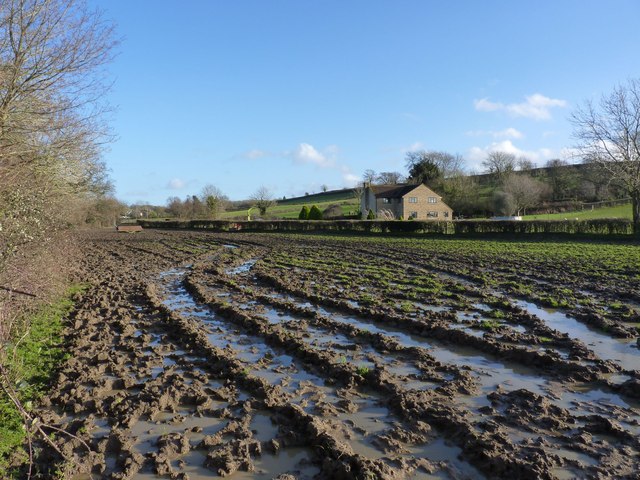‘God, I Hate That Field’ December 20, 2015
Author: Beach Combing | in : Medieval, Modern , trackbackYou are a modest farmer in one of the English shires and you have twenty fields to your name. Note that these fields are not the ‘quarters’ of the North American prairies, from Manitoba to Iowa. These are the irregularly shaped bits (often very small bits) of arable land begged from the landscape and from neighbours. To communicate with your family and your workers you need names, of course: and this is where the farmer’s ingenuity begins because there are only so many times you can call something ‘Green Acre’ or ‘Big Field’. In any case, literally tens of thousands of these field names have been recorded from the thirteenth to the twentieth century and Beach was recently enjoying a selection in Mark Field (really), English Field Names (1972). The best names are the fields that farmers hated: the fields that they broke their back over and still got little out of; the fields that were almost bad enough to give away. The soil is not an inch deep, stones protrude everywhere and there are holes that sheep fall into… And the tone? Well, imagine Piers Plowman in the thirteenth or Hodge in the nineteenth century, telling his wife, in the sludgy dark of pre dawn, that he was off to ‘Hell Hole/Huntitout/Judas’ etc etc and that he’d ‘probably’ be back by evening.
Cains Ground
Challenge Moor (might refer to a legal dispute)
Cold Kitchen
Come by Chance (difficult to find and far off)
Crazy Croft (land with an irregular boundary?)
Empty Purse
Famish Acre
Ginger Bread Close (might relate to strange shape, not sure?)
Handkerchief (small piece of land)
Heartache
Hell Hole
Hostage Wood
How Call That Field (not worth naming)
Huntitout (tiny field in the middle of nowhere)
Japan (field on the edge of the parish)
Judas
Kiss Arse Hill
Mizmaze (confused lay out with obstructions)
Mockbeggar (not even a beggar could live off this land)
Pennyless Pinch
Piddle Meadow (bad waterlogged land)
Poison Piddle (waterlogged and sterile, my absolute favourite)
Purgatory
Quarrelsome
Raw Bones
Shameful
Sour Acre (very popular name)
South Sea (a remote field)
Starvation Hill
Thieves Acre (land that robs time from the farmer?)
Traitor’s Meadow
Who’d Have Thought It (could be a complimentary name for a surprisingly productive piece of land, still…)
Whore Comb
The Wrong
Zulu Land (remote field)
Other offensive field names: drbeachcombing At yahoo DOT com in Britain or elsewhere.
22 Dec 2015: Neil H writes in ‘Your post on field names may result in a too lengthy response; I’ll endeavour to curb my enthusiasm. You omit ‘Beggars Bush’ on which I have a website http://www.beggarsbush.org.uk/how-to-use/ and more importantly an article in a peer reviewed journal (only one). The best article on the subject is John Field, Derogatory Field Names, Journal of the EPNS, 9 1976-77. Place Name research tends to be dominated by scholars of Old English, linguists and IT experts rather than historians. Lovely people and highly intelligent, esp., Richard Coates at UWE and Keith Briggs (who has a good article of Gropecuntlane). Finally, I would like to introduce you to one of those books which at first appear both unlikely to interest and to be dauntingly long but which turn out to be well written, informative and transformational. If I knew your address I would send you a copy but you’ll have to buy it as a Christmas present to yourself. I speak of Peter Chasseaud’s, Rats Alley; Trench Names of the Western Front 1914-1918 (2006) Spellmount, Stroud. Extracts as follows: p.18 Edmund Blunden Trench Nomenclature, in Undertones of War (1928)
“Genius names them, as I live! What but genius could compress
In a title what man’s humour said to man’s supreme distress?”
p.21 French name for German trench Tranchee des Homosexuels
p.44 In Feb 1918 when Zone Defence introduced one map showed Forward Zone, Battle Zone, with a line at the rear God Help Us line.
p.57 In 1914-15 most naming by troops on the ground, and when transferred to maps some were Bowdlerised, e.g. Stink Post to Odour/Oder Houses, and Shell Trap Farm to Mouse Trap Farm, though Shellfire, Shrapnel and Suicide Corners survived.
p.68 Blackadder’s for a support trench. Also Pear, Peach, Plum.
p.119 Queer Street in several places, from going to ruin, particularly mentions in Dickens.
p.126 Maud Allan trench named after a ‘free style’ dancer, who, in Salome in April 1918 provoked the headline in The Imperialist above an article accusing it of depravity, The Cult of the Clitoris.
See http://spartacus-educational.com/FWWallanM.htm
p.141 Napoo from “n’y a plus”.
Enough
Tacitus from Detritus of Empire writes: I thought it would tickle you to know that the custom of giving odd names to fields lingered on into modern times. A couple of generations back when my predecessors were Minnesota farmers they had a little patch of land a couple of miles away from the main farm. They called it “The Phillipines”. I don’t think anybody knew for sure why but it seems likely that it was a combination of it being quite a distance away by the horse transport of the times, and probably acquired around the time of the Spanish American war.
Thanks Neil, thanks Tacitus!
23 Jan 2016: A very old friend of the blog, Leif writes ‘According to tradition, a region of Pennsylvania’s Pocono Mountains the received its name when the Shakers (a religious sect) purchased the land sight unseen. Upon arrival, the discovered the land unarable and in their disappointment dubbed the area ‘Promised Land’. Farmers surely named barren fields ironically, and such names might prove more colorful than their more literal conterparts. Would a reader of Field recognize these for what they were?



